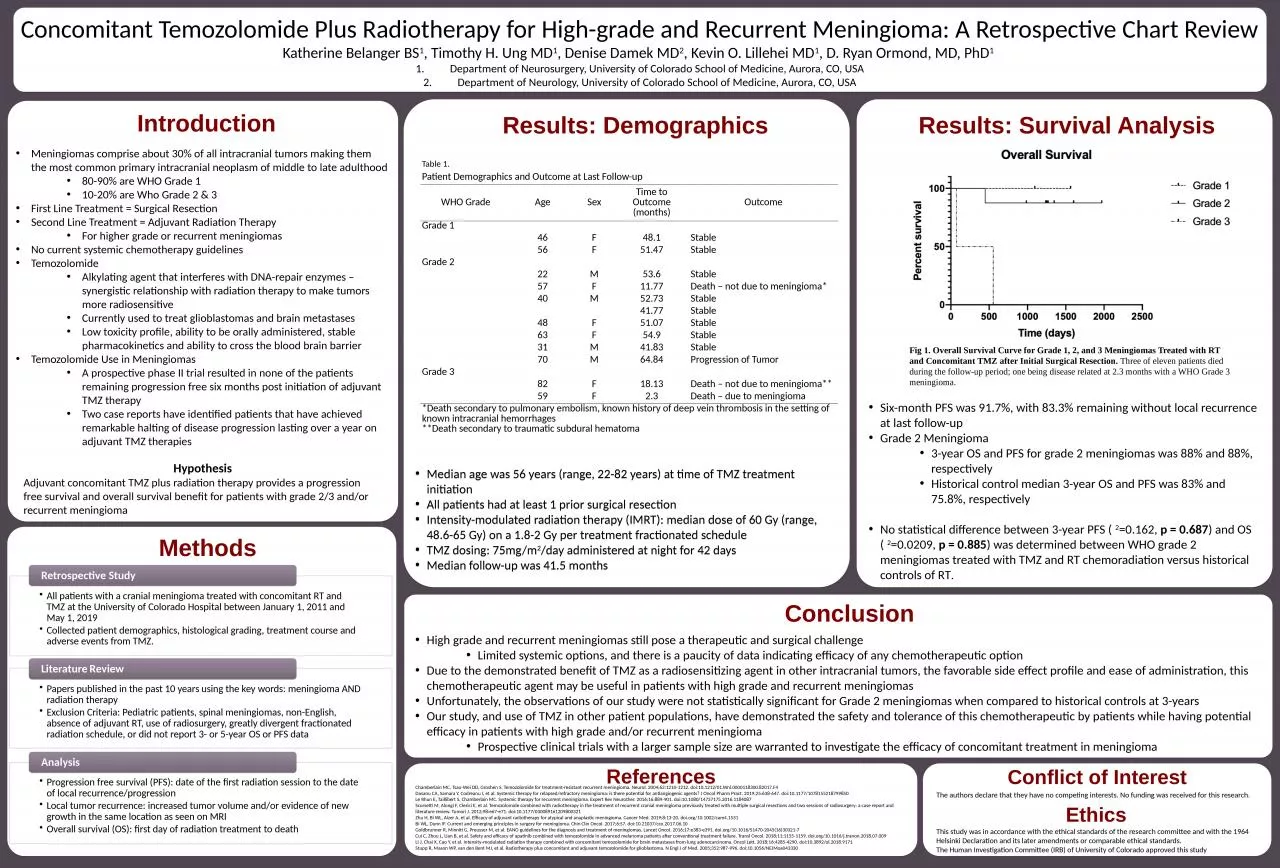

Katherine Belanger BS 1 Timothy H Ung MD 1 Denise Damek MD 2 Kevin O Lillehei MD 1 D Ryan Ormond MD PhD 1 Department of Neurosurgery University of Colorado School of Medicine Aurora CO USA ID: 1033269
Download Presentation The PPT/PDF document "Concomitant Temozolomide Plus Radiothera..." is the property of its rightful owner. Permission is granted to download and print the materials on this web site for personal, non-commercial use only, and to display it on your personal computer provided you do not modify the materials and that you retain all copyright notices contained in the materials. By downloading content from our website, you accept the terms of this agreement.
1. Concomitant Temozolomide Plus Radiotherapy for High-grade and Recurrent Meningioma: A Retrospective Chart Review Katherine Belanger BS1, Timothy H. Ung MD1, Denise Damek MD2, Kevin O. Lillehei MD1, D. Ryan Ormond, MD, PhD1 Department of Neurosurgery, University of Colorado School of Medicine, Aurora, CO, USADepartment of Neurology, University of Colorado School of Medicine, Aurora, CO, USAConclusionReferencesIntroductionMeningiomas comprise about 30% of all intracranial tumors making them the most common primary intracranial neoplasm of middle to late adulthood80-90% are WHO Grade 110-20% are Who Grade 2 & 3First Line Treatment = Surgical ResectionSecond Line Treatment = Adjuvant Radiation TherapyFor higher grade or recurrent meningiomas No current systemic chemotherapy guidelinesTemozolomideAlkylating agent that interferes with DNA-repair enzymes – synergistic relationship with radiation therapy to make tumors more radiosensitiveCurrently used to treat glioblastomas and brain metastasesLow toxicity profile, ability to be orally administered, stable pharmacokinetics and ability to cross the blood brain barrierTemozolomide Use in MeningiomasA prospective phase II trial resulted in none of the patients remaining progression free six months post initiation of adjuvant TMZ therapy Two case reports have identified patients that have achieved remarkable halting of disease progression lasting over a year on adjuvant TMZ therapiesMethodsResults: DemographicsResults: Survival AnalysisChamberlain MC, Tsao-Wei DD, Groshen S. Temozolomide for treatment-resistant recurrent meningioma. Neurol. 2004;62:1210-1212. doi:10.1212/01.Wnl.0000118300.82017.F4Dasanu CA, Samara Y, Codreanu I, et al. Systemic therapy for relapsed/refractory meningioma: is there potential for antiangiogenic agents? J Oncol Pharm Pract. 2019;25:638-647. doi:10.1177/1078155218799850Le Rhun E, Taillibert S, Chamberlain MC. Systemic therapy for recurrent meningioma. Expert Rev Neurother. 2016;16:889-901. doi:10.1080/14737175.2016.1184087Scorsetti M, Alongi F, Clerici E, et al. Temozolomide combined with radiotherapy in the treatment of recurrent cranial meningioma previously treated with multiple surgical resections and two sessions of radiosurgery: a case report and literature review. Tumori J. 2012;98:e67-e71. doi:10.1177/030089161209800321Zhu H, Bi WL, Aizer A, et al. Efficacy of adjuvant radiotherapy for atypical and anaplastic meningioma. Cancer Med. 2019;8:13-20. doi.org/10.1002/cam4.1531Bi WL, Dunn IF. Current and emerging principles in surgery for meningioma. Chin Clin Oncol. 2017;6:S7. doi:10.21037/cco.2017.06.10Goldbrunner R, Minniti G, Preusser M, et al. EANO guidelines for the diagnosis and treatment of meningiomas. Lancet Oncol. 2016;17:e383-e391. doi.org/10.1016/S1470-2045(16)30321-7Cui C, Zhou L, Lian B, et al. Safety and efficacy of apatinib combined with temozolomide in advanced melanoma patients after conventional treatment failure. Transl Oncol. 2018;11:1155-1159. doi.org/10.1016/j.tranon.2018.07.009Li J, Chai X, Cao Y, et al. Intensity‑modulated radiation therapy combined with concomitant temozolomide for brain metastases from lung adenocarcinoma. Oncol Lett. 2018;16:4285-4290. doi:10.3892/ol.2018.9171Stupp R, Mason WP, van den Bent MJ, et al. Radiotherapy plus concomitant and adjuvant temozolomide for glioblastoma. N Engl J of Med. 2005;352:987-996. doi:10.1056/NEJMoa043330CCCDTable 1. Patient Demographics and Outcome at Last Follow-upWHO GradeAgeSexTime to Outcome (months)OutcomeGrade 1 46F48.1Stable 56F51.47StableGrade 2 22M53.6Stable 57F11.77Death – not due to meningioma* 40M52.73Stable 41.77Stable 48F51.07Stable 63F54.9Stable 31M41.83Stable 70M64.84Progression of TumorGrade 3 82F18.13Death – not due to meningioma** 59F2.3Death – due to meningioma*Death secondary to pulmonary embolism, known history of deep vein thrombosis in the setting of known intracranial hemorrhages **Death secondary to traumatic subdural hematomaFig 1. Overall Survival Curve for Grade 1, 2, and 3 Meningiomas Treated with RT and Concomitant TMZ after Initial Surgical Resection. Three of eleven patients died during the follow-up period; one being disease related at 2.3 months with a WHO Grade 3 meningioma. Median age was 56 years (range, 22-82 years) at time of TMZ treatment initiationAll patients had at least 1 prior surgical resection Intensity-modulated radiation therapy (IMRT): median dose of 60 Gy (range, 48.6-65 Gy) on a 1.8-2 Gy per treatment fractionated scheduleTMZ dosing: 75mg/m2/day administered at night for 42 days Median follow-up was 41.5 months Six-month PFS was 91.7%, with 83.3% remaining without local recurrence at last follow-up Grade 2 Meningioma3-year OS and PFS for grade 2 meningiomas was 88% and 88%, respectivelyHistorical control median 3-year OS and PFS was 83% and 75.8%, respectively No statistical difference between 3-year PFS (2=0.162, p = 0.687) and OS (2=0.0209, p = 0.885) was determined between WHO grade 2 meningiomas treated with TMZ and RT chemoradiation versus historical controls of RT. High grade and recurrent meningiomas still pose a therapeutic and surgical challengeLimited systemic options, and there is a paucity of data indicating efficacy of any chemotherapeutic optionDue to the demonstrated benefit of TMZ as a radiosensitizing agent in other intracranial tumors, the favorable side effect profile and ease of administration, this chemotherapeutic agent may be useful in patients with high grade and recurrent meningiomasUnfortunately, the observations of our study were not statistically significant for Grade 2 meningiomas when compared to historical controls at 3-yearsOur study, and use of TMZ in other patient populations, have demonstrated the safety and tolerance of this chemotherapeutic by patients while having potential efficacy in patients with high grade and/or recurrent meningiomaProspective clinical trials with a larger sample size are warranted to investigate the efficacy of concomitant treatment in meningioma Conflict of InterestThe authors declare that they have no competing interests. No funding was received for this research.This study was in accordance with the ethical standards of the research committee and with the 1964 Helsinki Declaration and its later amendments or comparable ethical standards. The Human Investigation Committee (IRB) of University of Colorado approved this studyEthicsHypothesisAdjuvant concomitant TMZ plus radiation therapy provides a progression free survival and overall survival benefit for patients with grade 2/3 and/or recurrent meningioma
2.